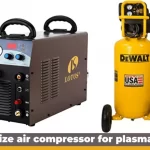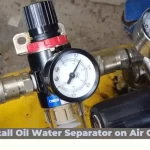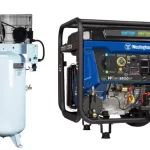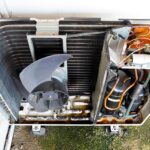Car owners agree that for a vehicle to remain in top shape for an extended period of time, proper maintenance is essential. You might have considered painting it at some point, but without shelling out a lot of money. It could refer to a color shift or a repair of damage.
You should not worry here since it is absolutely possible to paint or repaint your vehicle on a budget! An air compressor is all that is required.
The common question here is “Can you paint a car with a 30 gallon air compressor?” These compressors are very widely available, and if someone chooses to paint something, they typically consider whether the 30-gallon alternatives will be adequate or not.

Let me walk you through the most important factors in answering this question. Besides, at the end of the article you will find the how-to easy steps for spray painting your car with an air compressor. So stick till the end!
Looking for the best compressor for spray painting? Check a detailed review here.
Can You Paint A Car With A 30 Gallon Air Compressor
As a general guideline, you can definitely paint a car using a 30-gallon air compressor. In this case, the air compressor size is not particularly important. The CFM rating is what needs to be taken into account. A specific number of CFM is necessary for the air spray guns to operate. The paint sprayer won’t be able to spray the paint if there is not enough CFM.
How much CFM is required to spray paint, then? In order to spray paint, you must have a compressor that can deliver at least 3 CFM. If you plan to do that alone, the size of your patience is essential as well. The good news in this area is that the majority of air compressors with a 30-gallon capacity will operate at 3 CFM at 22 PSI.
These 30-gallon air compressors with that CFM rating will also fall into the affordable category. You can also get a 6.5 CFM air compressor that runs at 90 PSI if you can afford it. However, in that situation, you will want a specific nozzle with a wider range than typical.
What does CFM mean
CFM stands for cubic feet per minute. To put it another way, it indicates how much air is moved in a period of 60 seconds. The CFM should come first, followed by the PSI rating, and then the tank size when selecting an air compressor.
What does PSI mean
You may now be wondering what the PSI actually stands for. It stands for pounds per square inch, I suppose. It essentially expresses the air-dispersed pressure. The air pressure increases with a greater PSI rating.
A very high PSI does not ensure that the work will be even when it is finished. It does not guarantee an even painting, either. The compressor will store more air in the tank if the PSI rating is higher. As a result, the pressure of air that the tank releases over time is not quickly drained because there is more air being held. Additionally, it helps the compressor’s capacity grow.
Horsepower
A common abbreviation for horsepower is HP. The horsepower is the amount of power needed to fill up the compressor. Therefore, CFM and PSI are more important than horsepower. This is due to the fact that the majority of compressors have the necessary horsepower to operate.
Tank size
The least significant factor is this one. A deciding aspect will also be the kind of work you plan to do with the compressor in the future. The tank’s dimensions provide an even application of paint on the entire vehicle.
Wondering how to fill paintball tank with air compressor? Check 7 easy steps here.
Can you paint a car with a 30 gallon air compressor: How-to User Guide
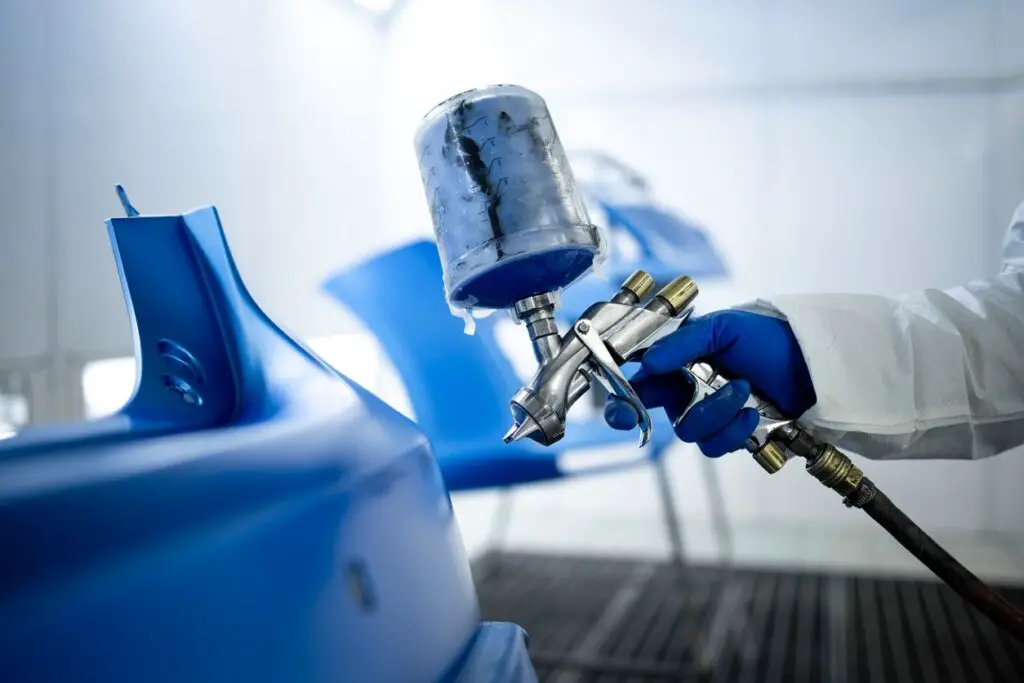
You will require an air compressor with at least a 3 CFM rating, as we’ve already determined. You must comprehend the procedure and processes required before painting your car. The first part of the story is finding an appropriate air compressor. Besides that you would require the following:
- 30 gallon air compressor
- Spray gun
- Sandpaper
- Masking tape
- Old newspaper or magazine
- Personal Protective Equipment (Safety glasses, pair of gloves, dust mask, respiratory mask)
- Desired color os paint
- Primer
- Topcoat
Now let’s see the steps involved in the process:
Step 1: Prepare air compressor
First, you need to get the air compressor ready. This is the easiest part, by the way.
Start by turning on the compressor and allowing it to gather air. You must make sure that the pressure is regulated properly when there is an air buildup.
Check the spray gun requirements in the regulations. It should specify how much PSI is necessary.
Adjust the compressor’s pressure accordingly.
Next, join the hose to the sprayer using the couplings.
Having trouble getting the hose to fit through the couplings? These actions will assist:
- Add some thinner to the sprayer cup.
- Open the metering valve very slightly.
- Squeeze the trigger with the nozzle turned away.
- You should observe air dispersing with the thinner after pulling the trigger.
- You can proceed to pour the remaining thinner into the cup if the thinner does come out.
Step 2: Continue with preparation
It’s time to choose the thinner and paint after you’ve set up the air compressor. Besides, you should be preparing the area for car painting and getting the appropriate PPE (personal protective equipment) to protect your body from paint spillage.
In case you are wondering why you need the thinner, it’s there to ensure that the paint flows freely via the nozzle and siphon tube. The paint is fairly thick on its own. Additionally, the thinner will assist in somewhat thinning it. You will ruin the entire project if you use paint without thinner.
Cover the floor you are now working on with old newspapers or magazines since there may be paint spills, which could make your workspace untidy. Besides, it will be challenging to clean up the paint spills from the floor.
Besides, if you do not want to paint the whole car, use magazines or newspapers to cover the surfaces you do not want to be painted. To attach papers to the surface, use masking tape. You should also build a fence around the surrounding area to make sure the paint won’t be able to spread all over the place.
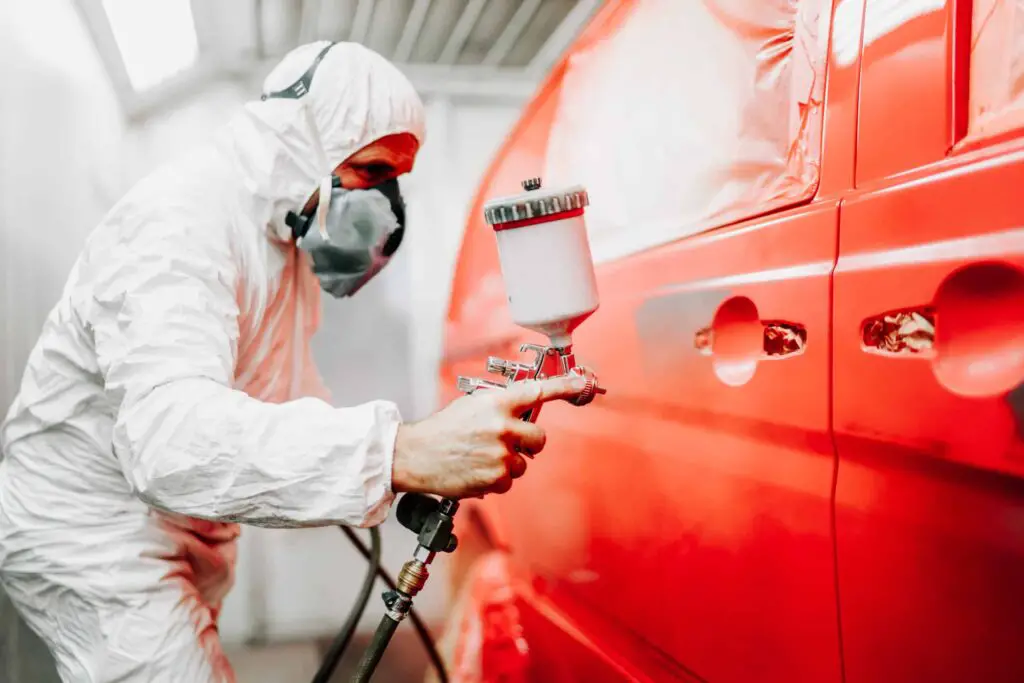
Step 3: Painting process
Applying primer to the surface is advised before using the painting gun once more. The primer will help to apply the paint to the surface easily. Additionally, it will effectively hide the metal.
However, thoroughly mix the paint before adding it to the clean container. To make sure the color is aggressive, you will also need to add the proper amount of thinner. The paint-to-thinner ratio will depend on the paint you plan to use. After mixing the paint and thinner, pour the mixture into the cup until it is 2/3 full, and then seal it.
Now we are getting to the painting job. Before pulling the trigger, have a firm grip on the gun because there will be a lot of kickbacks. After that, pull the trigger to begin painting the surface.
Here it is very important to avoid holding the rifle at a 90-degree angle. Hold the paint gun at a parallel angle instead. This will ensure you efficiently cover the majority of the area.
While you are spray painting, make every effort to avoid stepping in any drips. Keep painting till there is no more paint in the cup. Remove the cup if you need to pause and rest.
One thing you need to make sure of is that you shouldn’t recoat a layer until it has dried. After applying the first coat, if you believe that the surface will need another coating, wait until the layer has dried before continuing.
If you are looking for how to build a high pressure air compressor, check the complete guide here.
Step 4: Cleaning up
The cleanup procedure is the project’s last and most crucial factor. You can’t just call it a day with paint on the cup or drips on the paper. Move the remaining paint to its original container instead. Remove the tape you placed on the surface when the paint dries.
NB! If you intend to remove the tape or paper from the surface before the paint dries, you risk having the tape pull off the paint’s top layers. One of the essential factors is that you wait until the surface has dried completely before removing anything from it.
However, you should wipe the area as soon as you can if the paint has spilled on it. Dried paints are difficult to remove, and you may even need specialized cleaners or chemicals to remove the paint from the floor if it is dried. Because of this, you ought to begin cleaning the floor as soon as you can.
Conclusion
So, can you paint a car with a 30 gallon air compressor? We hope that you found the answer to your question. As you can see, a 30-gallon air compressor may be used for spray painting cars. Most air compressors of this size can supply your paint sprayer with the CFM and PSI it needs.
You might have heard people say you need pneumatic tools that produce more than 20 CFM in order to paint your entire car. Well, to a certain extent, this is true. You can definitely paint a car more quickly with a larger spray gun and higher CFM, but you can still cover the entire vehicle with a smaller air compressor. It will be fine to use a 30-gallon compressor and a sprayer with a 3 CFM rating or above.
FAQs
What size air compressor do I need to paint a car?
In this case, it is not the size of the air compressor that is important. It is mainly about how many cfm the compressor can deliver to do the spray painting job. To paint a car 30 gallon air compressor with at least 3 CFM at 22 PSI will work. Surely, the bigger compressor is and the higher the CFM rating is the faster and more easily you will do the paint job.
Is a 30 gallon air compressor enough?
Yes, it is enough. The 30 gallon air compressor can be used for residential, commercial, and industrial applications. They offer compressed air capable of powering a range of tools.
Can a 20 gallon air compressor paint a car?
A smaller compressor like 20 gallon compressor is good for small operations. For painting a car you should choose a bigger compressor.
Will 26 gallon air compressor paint a car?
You can’t paint a full car or van with this compressor. A 26 gallon compressor would quickly run out of pressure since your 1.8 horsepower compressor cannot pump enough air for you. If you break the job up, you might be able to get away with it, but it will take some time.

